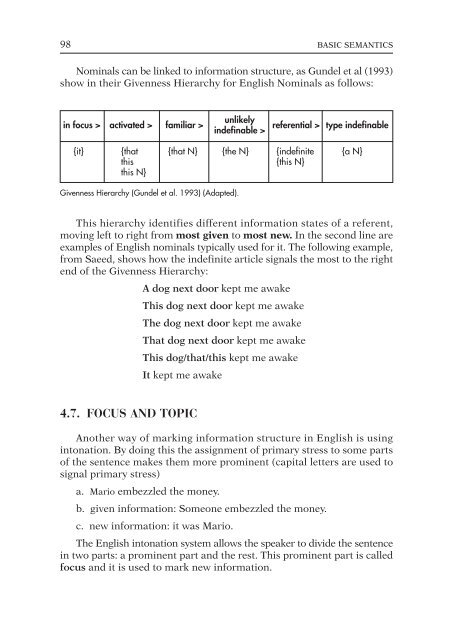Semantics
You also want an ePaper? Increase the reach of your titles
YUMPU automatically turns print PDFs into web optimized ePapers that Google loves.
98 BASIC SEMANTICS<br />
Nominals can be linked to information structure, as Gundel et al (1993)<br />
show in their Givenness Hierarchy for English Nominals as follows:<br />
in focus > activated > familiar ><br />
unlikely<br />
indefinable ><br />
referential > type indefinable<br />
{it} {that {that N} {the N} {indefinite {a N}<br />
this {this N}<br />
this N}<br />
Givenness Hierarchy (Gundel et al. 1993) (Adapted).<br />
This hierarchy identifies different information states of a referent,<br />
moving left to right from most given to most new. In the second line are<br />
examples of English nominals typically used for it. The following example,<br />
from Saeed, shows how the indefinite article signals the most to the right<br />
end of the Givenness Hierarchy:<br />
A dog next door kept me awake<br />
This dog next door kept me awake<br />
The dog next door kept me awake<br />
That dog next door kept me awake<br />
This dog/that/this kept me awake<br />
It kept me awake<br />
4.7. FOCUS AND TOPIC<br />
Another way of marking information structure in English is using<br />
intonation. By doing this the assignment of primary stress to some parts<br />
of the sentence makes them more prominent (capital letters are used to<br />
signal primary stress)<br />
a. Mario embezzled the money.<br />
b. given information: Someone embezzled the money.<br />
c. new information: it was Mario.<br />
The English intonation system allows the speaker to divide the sentence<br />
in two parts: a prominent part and the rest. This prominent part is called<br />
focus and it is used to mark new information.



